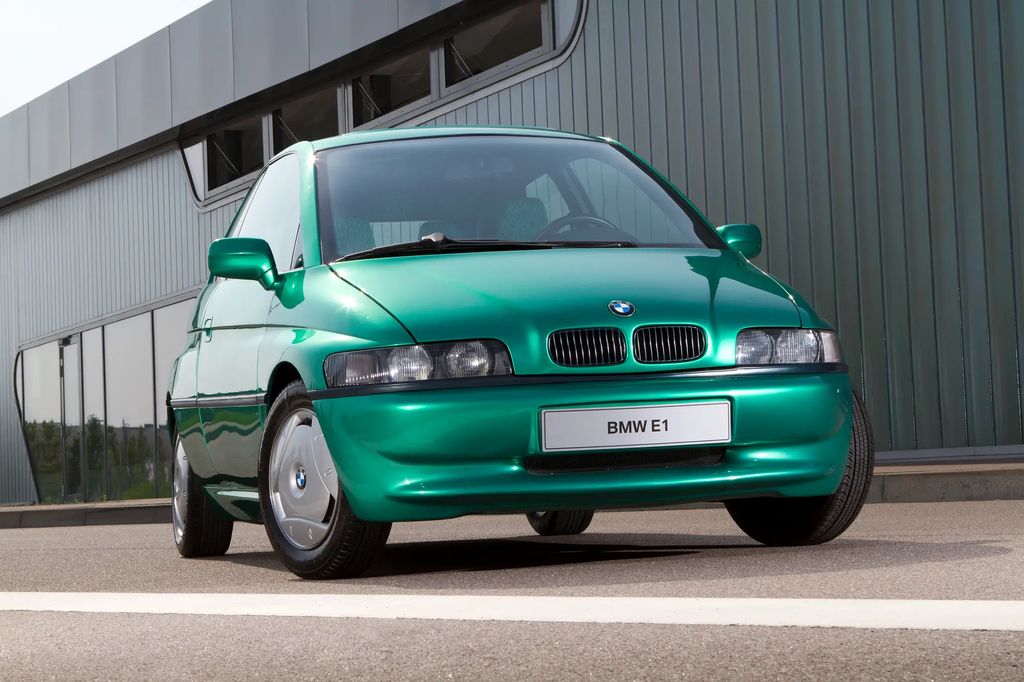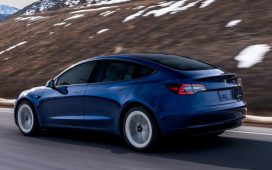By the end of the 20th century, electric vehicles had seen more fits than starts. The gas crises of the 1960s and 1970s led to some fascinating experiments, but they were ultimately just that—experiments that never yielded mass-production cars.
But those decades also helped launch an environmental movement concerned with the consequences of so much economic growth. If you grew up in the 1980s and 1990s, you certainly remember hearing about the ozone layer, saving the whales, recycling and cutting back on pollution. And regulators started pushing car companies in a greener direction.
By the mid-1990s, manufacturers were launching limited-production electric vehicles, mostly to test the market. The California Clean Air Act passed in 1988, and then the state’s first Zero Emission Vehicle mandate passed two years later, helped spur the development of production EVs not just in the state or the country but around the world.
Many of the EVs launched in the 1990s were created as a direct result of its enactment, and subsequent amendments put pressure on automakers to come up with viable production EVs. But as always, getting there isn’t always a straight line.
(Welcome to The History of Electric Vehicles, where we’ll cover the many ways that EVs have been a part of more than 150 years of automotive history. In this installment, we’ll look at EVs’ role in the earliest days of the horseless carriage. Also read part one, part two, part three and part four of the series.)
The Rise Of The Modern Electric Car
California’s original ZEV mandate was a very big deal. It put in motion a process that would require a small but gradually increasing amount of cars sold in the state (and the several other states that follow California emissions rules) to be zero-emission by the end of that decade. At the time, and, as now, that primarily meant electric vehicles—in this case, 2% by 1998.
Concurrently, and in response to the way things were going, General Motors began developing the EV1, which went into production in 1996. It is the first ground-s electric car to reach production, and there’s quite a bit of controversy about it even today.
Yet the EV1 was a genuinely good and well-engineered electric car for its time. The first, probably.
It had a 137-hp motor that drove the front wheels, allowing it to sprint to sixty in 8.9 seconds. Its 26 lead-acid batteries provided a usable range of up to 90 miles, which was a great number for a mid-1990s EV. It drove well too and had a futuristic interior with a centrally mounted digital instrument cluster like many electric cars have today.
The EV1 was the world’s first purpose-built EV that had enough range and performance to be a real alternative to combustion cars—it was excellent, according to those who drove it back in the day.
However, GM only leased the 1,100 or so EV1s it produced without giving the option to buy the car. When the leases ended, it collected all the EV1s (most of which were still in perfect working order) and scrapped them to the dissatisfaction of the leasees. This was unfortunately not the first time that GM fumbled when it came to launching new technology.

The EV1’s rise and fall was later documented in the 2006 film Who Killed The Electric Car?, as well as its 2011 sequel, Revenge of the Electric Car. Both remain relevant today as the entire industry faces a transition that feels more and more inevitable.
Other EV Attempts Break Ground In The 1990s
Other manufacturers started to regain interest in making EVs in the 1990s mostly because they wanted to keep selling cars in California and the states that followed its rules.
Mercedes, BMW and other automakers began extensive testing with EV-converted prototypes based on their existing models in the 1980s and continued into the next decade, but they didn’t put any models into production. Several startups took the reins instead.
One of the first EVs of the 1990s was another conversion, the Solectria Force, which was a Geo Metro at heart, and very similar in its idea to the later Coda sedan.
The Solectria Force was introduced in 1991 and priced at $33,995, and it had a lead-acid battery pack that gave it a range of 50 miles at 45 mph. There was also a nickel-metal hydride version available, which had double the range, but it cost a whopping $88,895.
Peugeot introduced an all-electric version of its 106 city car (called the 106 Electrique) in 1995, whose 12 kWh nickel-cadmium battery pack was good for about 60 miles of driving on flat roads at moderate speeds. The French automaker was expecting it to be a hit, but it ultimately only made 6,400 106 Electriques by 2003, when production ended, and they were all sold exclusively in Europe.
The 1997 to 2003 Toyota RAV4 EV was the Japanese manufacturer’s first series production EV, introduced to comply with California’s ZEV mandate. It had a 27.4 kWh nickel-metal hydride battery that gave it an EPA range of 95 miles. Straight-line performance wasn’t its strong suit, with 67 hp and an acceleration time to 60 mph of around 18 seconds.
It could charge its battery at a maximum rate of 6 kW, requiring about 5 hours to go from flat to full. Toyota launched the second-generation RAV4 EV in 2012 and production ended in 2014. Another EV created for California is one of the EVs from Honda’s past, the EV Plus, made between 1997 and 1999. It was an electric version of the Honda Logo city hatchback, which got a 28.7 kWh battery good for up to 105 miles of range. Only around 300 examples were made.
Nissan also made an electric version of a crossover it was already producing, the R’nessa, which in EV form became the Altra. It was introduced in 1997, and only sold in Japan in limited numbers, but it’s significant because it’s the first production electric vehicle to have a lithium-ion battery pack, which featured 96 cells sourced from Sony arranged in 12 modules. It had a claimed range of 120 miles on one charge.
Ford decided to turn its Ranger pickup into an EV and created the Ranger EV—this is the first electric pickup made in America in significant numbers. It had a 20.7 kWh battery pack that provided about 70 miles of range, and it had a top speed of 75 mph. Around 1,500 units were built between 1998 and 2002.
Norway-based Pivco’s Th!nk City also deserves a mention because it is one of the first EVs to make real practical sense. It was a small city runabout like many tiny EVs before it, but with up to 13.8 kWh of battery capacity in later models and a range of 60 miles on a full charge, it found favor with many urban drivers in its native Norway, as well as other European countries. Around 1,000 were built.
It was very similar to the REVAi, which is better known by its UK market name, the G-Wiz. This Indian-made EV was in production from 2001 until 2013, and it sold over 4,600 units around the world. Unlike the Th!nk, which was quite expensive for a small city car, the G-Wiz had affordability on its side, with prices starting around the $13,000 mark.
Lead-acid batteries in the original model provided a range of roughly 50 miles, but the later addition of an optional lithium-ion pack increased the range to 75 miles.
California Slows Down
But a few things dampened the evolution of EVs in the 1990s. For one, cheaper fuel than in past decades and changing consumer trends led buyers to favor gas-guzzling SUVs and trucks, and automakers were happy to oblige. Then, after intense lobbying by the oil and auto industries, California backed off its ZEV mandate in 1995. Lacking a regulatory reason to go electric, many automakers including GM sidelined their products and pit EVs on the backburner.
In another “then as now” moment for EVs, a New York Times report from 1995 details many of the same issues the technology faces today: concerns over being truly “green” if they get power from coal and fossil fuel sources, weight, fires and range. And in truth, the lithium-ion battery industry that now powers all modern EVs was still in its infant stages:
“Right now, the state of the art in battery technology is such that it’s too early to put it on the road,” said Henry Wedaa, chairman emeritus of the South Coast Air Quality Management District in Southern California. “If we introduce electric vehicles too soon, before the technology is ready, we are riding for a fall with a lot of potential consumers, and they will be unwilling to buy future electronic vehicles, which will be outstanding.”
Dennis Simanitis, engineering editor of Road & Track, an automobile enthusiasts’ magazine, said tests of the current electric cars had found none with a range over 100 miles, and the average was only about 60 miles between rechargings. And unlike gasoline-powered cars, which run the same with a quarter tank of fuel as when they are full, electric cars begin losing power as the batteries are discharged, he said.
“Even if you are for electric cars, there was quite a danger of the electric car that could come out in 1998 being unacceptable for everybody,” Mr. Simanitis said. “This will give the industry some breathing room to look for a better battery.”
In this world, what’s new is always old in some way. Some in the late 1990s even pointed to a future more centered around fuel cell vehicles, but three decades later, those are even further behind modern EVs.
But the idea had still captured the hearts and minds of many people. And in the coming decade, a new player would emerge that would change everything.
Did You Know?
Released in 1991, the BMW E1 concept is often cited as the predecessor to the current i3. A four-passenger EV, it was capable of up to about 125 miles per charge and made copious use of lightweight materials. Sadly, it was never put into production.










